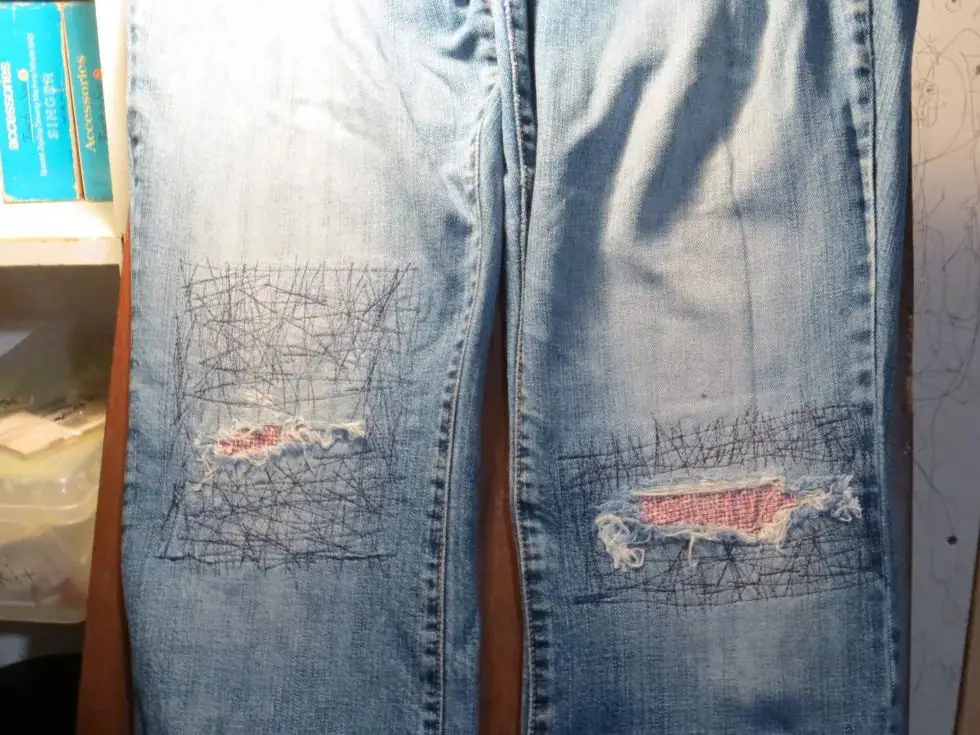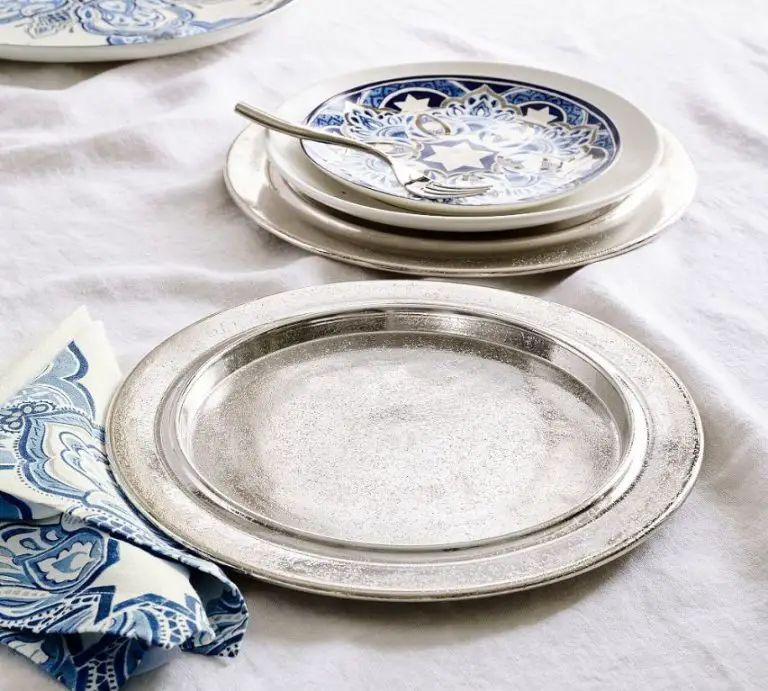How Do You Fix A Hole In Jeans Between Your Legs?
Assess the Hole and Determine the Best Repair Method
The first step is to examine the hole closely. Pay attention to the size, location, and type of fabric. A small hole in a discreet area may only need darning, while a larger hole or one in a high-friction area might require a patch for reinforcement.
For small to medium holes in sturdy denim, hand-darning the hole by stitching back and forth across it is often the easiest DIY method. Use a needle and sturdy thread in a matching color. Try to replicate the weave of the denim as you sew. Refer to this visual guide on darning https://www.thesprucecrafts.com/how-to-darn-a-hole-2978569
Large holes, holes in stretchier denim, or holes in high-friction areas prone to more wear may need a denim patch. This involves cutting a patch of denim in a matching color and stitching it over the hole for reinforcement. The patch can be on the inside or outside of the jeans.
For very distressed jeans or to add some style, try visible mending by creatively stitching over the hole in a contrasting thread color. This draws the eye to the repair as a decorative detail. Look for inspiration from sashiko or other decorative mending techniques.
Gather Your Materials
Before you can repair the hole in your jeans, you’ll need to gather the right materials. The main items you’ll need include:
- Denim patches – Cut a patch out of spare denim or purchase an iron-on denim patch. Make sure it’s large enough to fully cover the hole with at least a 1/2 inch border all around.[1]
- Embroidery floss – Use floss that matches the color of your jeans as closely as possible. You’ll need at least 6 strands for darning.[2]
- Embroidery needle – A sharp needle will make it easier to stitch through the thick denim.
- Sewing machine – Optional, but can make quick work of sewing on a denim patch.
- Iron-on adhesive – Helps adhere patches and provides an extra layer of reinforcement.
In addition to these main supplies, you may also want straight pins, fabric scissors, and needle nose pliers. Having the right materials on hand will ensure your jeans repair goes smoothly and lasts a long time.
Prepare the Area Around the Hole
Before repairing the hole, you’ll need to clean and prep the area so the patch or mending will hold. Start by cutting away any loose threads around the hole using sharp scissors. Removing stray threads will help prevent further unraveling. According to the MasterClass article “How to Fix Ripped Jeans: 6 Methods for Patching Denim,” it’s important to “trim any loose, frayed edges around the hole,” so the repair will be secure (source).
Next, launder the jeans according to care instructions, using mild detergent. Washing will remove dirt or oil from the fabric. It’s best to air dry rather than machine dry, to avoid any additional fraying or shrinkage around the hole.
Once cleaned and fully dry, lay the jeans flat and iron the area around the hole. Use the iron on a medium heat setting, being careful not to scorch the denim. Ironing will help flatten the fabric, making it easier to sew the patch or stitch the hole closed.
Sew a Denim Patch
One common way to repair a hole in jeans is by sewing a denim patch over the hole. This is a simple and effective repair for holes of any size and works on the crotch seam between the legs as well. Here’s how to sew a patch successfully:
First, trim a patch of denim about 1-2″ wider on all sides than the hole you are covering. Place the patch underneath the hole so it fully covers the hole and extends beyond the worn edges. Pin the patch in place. Be sure to match the denim grain to avoid puckering or distortion.

Thread your needle with a denim thread that matches your jeans in color. Start by stitching around the edges, removing pins as you sew. Make tight stitches close together around the perimeter to secure the patch well. Remove any gaping around the hole first by stitching across the hole a few times. Then sew around the full perimeter. Try not to catch the top layer in your stitches so the sewing remains invisible.
Avoid making seams too bulky by keeping stitching tight and only going through a few layers at a time rather than the full stack of denim. This will help the patch lie flat and prevent uncomfortable bunching between your legs (source).
Darn the Hole
Darning is a simple and effective method for mending small holes and worn areas in jeans. This technique involves using a darning needle and thread to weave over the hole, reinforcing the fibers of the denim. To darn a hole:
First, thread a darning needle with thread that matches the color of your jeans as closely as possible. You’ll want to use a heavier thread like topstitching thread or buttonhole twist. Cotton embroidery floss can also work well for darning denim.
Next, stretch the jeans over a solid surface like a cutting board to make the hole taut. Start weaving the thread horizontally across the hole, spacing the stitches close together. Do not pull too tightly or the denim may pucker. Weave vertically over the horizontal stitches in the same manner to create a woven patch.
Weave the needle in and out across the hole, reversing direction each time you reach the edges. The repeated weaving motion will reinforce the damaged fibers around the hole. Take care to maintain even tension as you weave to prevent puckering of the denim. Continue darning until the hole is fully covered.
Once finished, knot the thread on the inside of the jeans and trim any excess. Gently wash the jeans and allow to fully dry to set the darning stitches in place. With a sharp needle and closely spaced thread, darning can make holes nearly invisible, restoring strength and life back to your favorite jeans.
Try Visible Mending
Visible mending embraces the hole in the jeans by turning it into a design feature. With visible mending, stitches are used to decorate and highlight the hole, rather than disguise it. Popular visible mending techniques include sashiko, a Japanese embroidery style that uses simple running stitches in geometric patterns.
To try visible mending on a hole in jeans:(https://egausa.org/visible-mending-introduction/)
- Choose an embroidery pattern that will extend beyond the edges of the hole, like a flower or starburst shape.
- Use embroidery floss or thread in a contrasting color to the jeans.
- Embroider your design over the hole using basic stitches like running stitch or backstitch.
- Make the hole a decorative feature by centering the design over it.
- Consider adding extra details like French knots or seed beads.
Visible mending highlights the unique character of the worn jeans. It takes skill to artistically incorporate the hole into an embroidered design. Visible mending is a great way to revive jeans sustainably and give them new life.
Use Iron-On Adhesive
One quick and easy way to repair a hole in jeans is by using an iron-on adhesive patch. This allows you to bond a denim patch over the hole without having to sew. Here are the steps:
Choose an iron-on adhesive such as HeatnBond UltraHold that works specifically for fabrics like denim. Cut a patch out of scrap denim at least 1-2 inches wider on all sides than the hole. Follow the adhesive instructions to apply it to the back of the denim patch and around the hole. Place the patch over the hole and iron it in place using a dry iron on the cotton setting. Hold the iron over each area for 10-15 seconds. Let it fully cool before wearing.
The iron-on adhesive will create a strong, permanent bond. With the right product, this method can be almost as durable as sewing. It creates a smooth finish without visible stitching. Just be sure to follow the heating instructions carefully or the patch may not adhere properly. This quick fix helps extend the life of your favorite jeans.
Reinforce the Repair
Adding reinforcement to the repair will help prevent the hole from reopening. One of the best ways to reinforce the area is by adding bar tacks. Bar tacks are a type of stitch made by a sewing machine that creates a zigzag pattern. They are extremely strong and durable. Bar tacks are commonly used to reinforce areas of stress on clothing, such as belt loops, pockets, and fly openings. According to https://denimbmc.com, bar tacks provide focused strength by spreading tension over a small area of fabric.
To add bar tacks, first identify the main stress points around the repaired hole. Mark the fabric with chalk or a fabric marker. Next, set up your sewing machine for a zigzag stitch, with a short stitch length and narrow stitch width. Lower the presser foot and stitch over each marked stress point to create the bar tack stitches. Make sure to anchor the bar tacks by backstitching at the start and end. Add several bar tacks both above and below the repaired hole for the strongest reinforcement. The added bar tacks will help prevent the jeans from splitting open again in the future.
Smooth and Finish
After you have completed the repair, there are a few final steps to help the area look tidy and blend in. First, carefully trim any loose threads around the edges of the patch or darning using sharp scissors. Make sure not to cut into the denim itself. Next, wash the jeans according to the care instructions, using mild detergent. This will help soften the fibers and allow the patch to settle into the surrounding fabric.
Once washed, lay the jeans flat and press the repaired area with a warm iron. Avoid ironing directly on any patches or embroidery. The heat will help flatten the material and improve adhesion. Check the underside of the patch to ensure full contact with the jean fabric. Finally, rub the edge of the repair gently with fingertips or fine-grade sandpaper to distress the edges for a more natural look. This helps conceal the repair and makes it less visibly obvious. With these finishing touches, your mended jeans will look and feel as good as new.
Prevent Future Inner Thigh Wear
Once you’ve repaired the hole in your jeans, you’ll want to take steps to prevent future wear and tearing between the legs. There are a few simple ways to make your jeans last longer:
Patch preemptively. Apply small patches or reinforcing material like iron-on interfacing to the inside of your jeans before holes develop. This will strengthen the fabric and prevent abrasion in high-friction areas.
Don’t overdry. Line dry your jeans or use the delicate cycle and low heat when machine drying. High heat can damage denim fibers over time.
Wash less often. Frequent washing and drying causes jeans to fade and break down faster. Spot clean when possible and wash jeans only when dirty.
Consider applying a sealant like Scotchgard to high wear areas, which can reduce friction. And moisturize your skin to avoid irritation from rubbing.
Wear thigh bands/anti-chafing products if you frequently experience thigh rub. Compression shorts or leggings under jeans can also help.
Inspect your jeans regularly and repair holes as soon as they develop. Taking quick action can stop a small hole from turning into a large rip.


